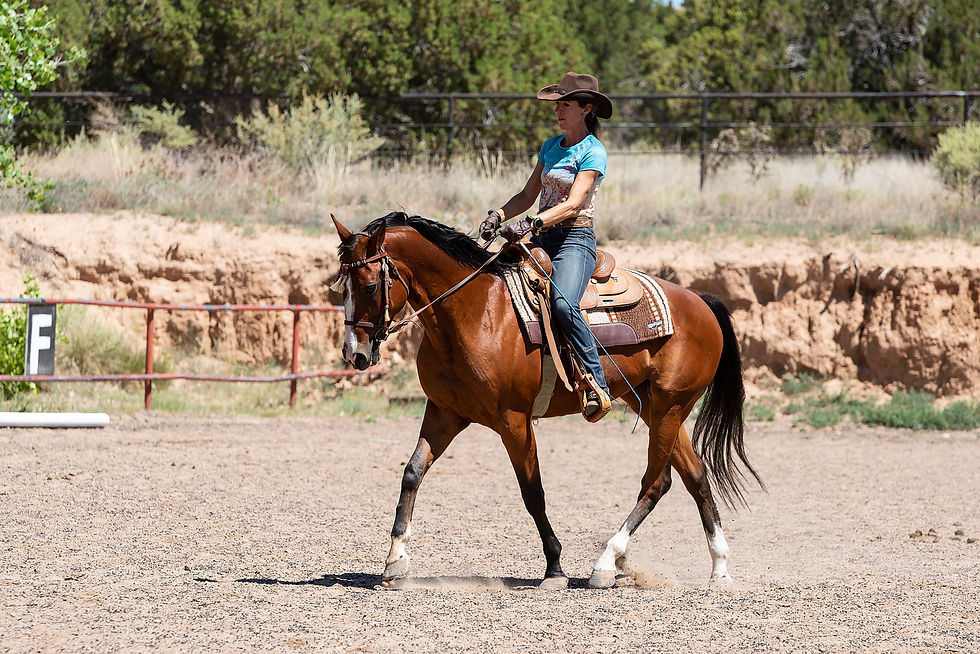Yes, You Can Solve Contact Issues
- Katrin Silva
- Nov 30, 2023
- 3 min read

Many horses who come to me for training have contact issues. Contact can be tricky. Horses learn to avoid honest contact by leaning on the bit, curling behind it, or bracing above it. Horses express their tension, frustration, or confusion by opening their mouths, sticking their their tongues out, or grinding their teeth. We can’t blame these horses. They react to unyielding or bouncy hands, or the the wrong kind of bit. They may have a sore back. They may need a chiropractic adjustment, or dentistry. Even if nothing is physically wrong, many of them simply don’t understand what their riders are asking them to do.
I’ve heard it said that contact issues are impossible to fix. This can be true, in some cases. Horses are like people when it comes to habits. Once they become used to a defensive pattern, they tend to continue even when their rider doesn’t give them a reason anymore. But most of them can learn that the good, correct kind of contact with a quiet, sensitive rider’s hand feels much better than the defensive pattern. The trick is to show them the way.
My go-to approach to contact issues is to break the habit by changing the conversation. When a horse is used to arguing with my hands, I don’t participate. This often means giving up all thought of contact for a while. Once the horse is moving freely forward on a loose rein, once the horse truly understands the basics of “Go!” and “Whoa!” I can reintroduce the contact.

Learning to stretch forward and down is an essential part of teaching correct contact. A horse who moves willingly into the contact is trusting my hands. I never want to abuse this privilege. I never want to force the horse into a frame he can’t hold or isn’t ready for. I never want the horse to stay in one outline for so long that it becomes uncomfortable. Think of your favorite yoga pose, then imagine having to hold that pose for 45 minutes without a break. I want the horse to know that I will allow him to stretch at regular intervals. I want the contact to be pleasant, not a chore or a pulling match. Stretching forward and down is also a good way of checking whether the contact was correct. If the horse won’t stretch forward and down when I offer a longer rein and a lighter seat, we’ve got to work on forward energy, relaxation, or body alignment.

The leg yield is another effective way to change a conversation stuck in a holding pattern, aka bracing. I essentially refuse to brace back by encouraging a little bit of sideways movement instead of pushing the horse straight forward. When the horse is rushing in addition to bracing, I practice leg-yields on smaller circles. Leg-yielding helps the horse find a steady rhythm, better body alignment, and a more relaxed back. This works especially well on horses with a well-developed underneck. These horses often were ridden in tie downs or standing martingales, which covers up the problem with a band-aid. The first thing such horses do when I rip off the band-aid is to keep looking for the tie-down, which initially makes them look worse. But once they learn how to move forward and sideways, they usually figure out how to stretch forward and down from there, because the hollow, braced way of going never felt great to begin with.

Horses who were ridden in harsh bits or horses whose riders yanked on their mouths have good reasons to not trust the rider’s hands. In those cases, I reintroduce contact in a “wherever you go, there I go” fashion. This means my hands move quite a bit - but with the horse, not against it. Whether the horse’s head moves higher, lower, or to the side, I maintain a light and following contact with the horse’s mouth, not correcting, not pulling, not asking for anything - just going along, without pressure, without expectation. From there, we progress to re-introducing the meaningful contact, with half-halts. But trust in my hand not aiming to hurt has to come first.
You might ask why anyone would bother with contact at all, if there are so many ways to get it wrong. Of course, many horse-rider pairs never worry about contact and do just fine. But contact, if you do it right, can elevate your horsemanship. If you want your horse to become a true athlete, able to carry you comfortably, an understanding of contact is essential for developing the topline muscles. If you want to improve communication between you and your horse from haphazard to subtle and nuanced, contact is a great tool. It’s worth it. Really.



Comments